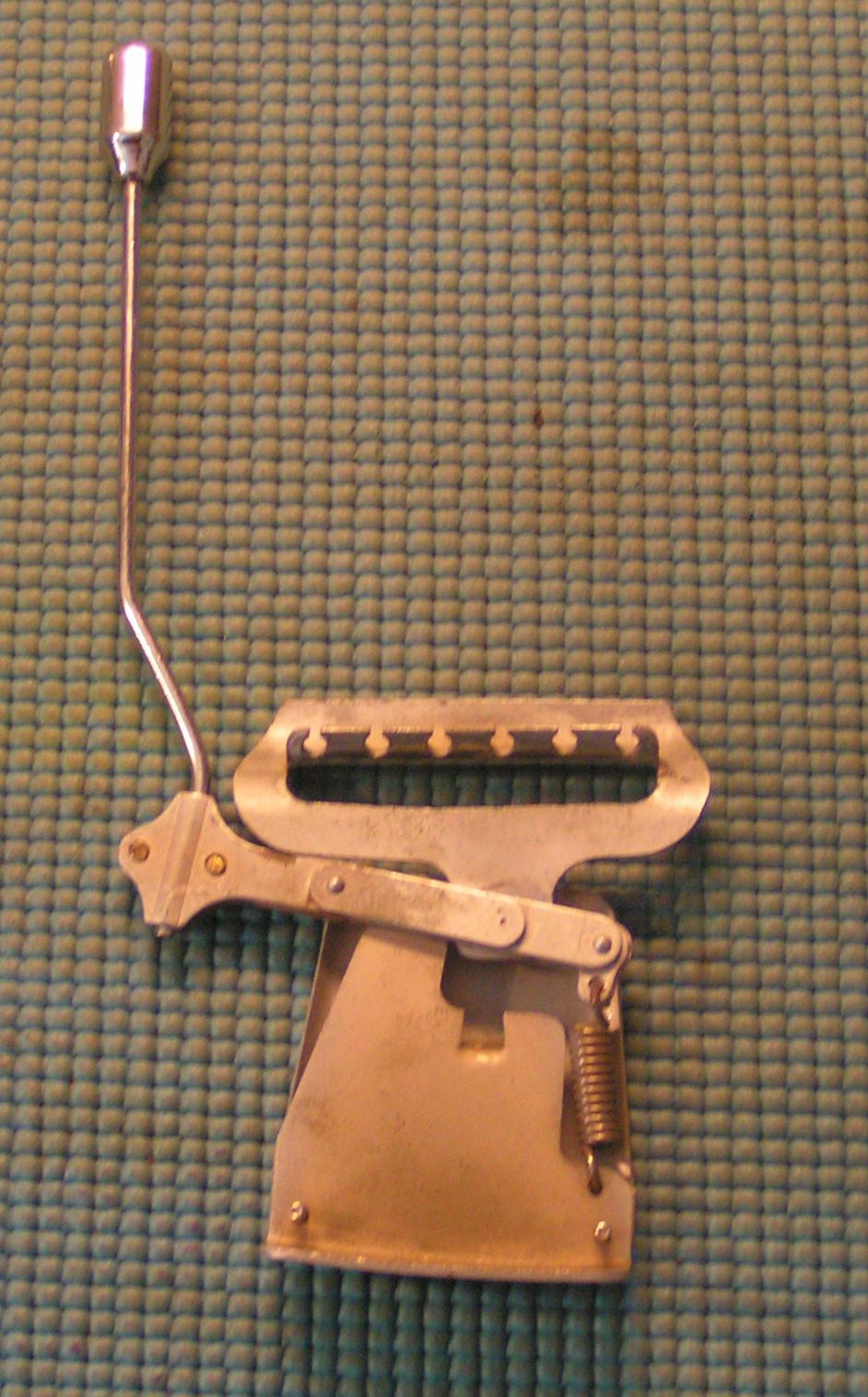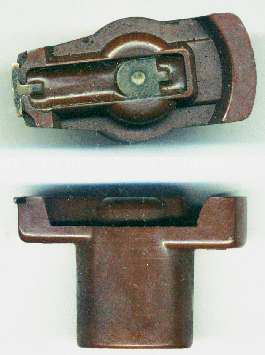|
Electro-Spanish Model B
The Electro-Spanish Model B was the world's first production, solid body ( Bakelite) electrified lap steel guitar, officially released in 1935 by Rickenbacker. Commercially, it was the most successful musical instrument manufactured by Rickenbacker. Though not entirely solid - it had thick plastic (Bakelite) walls and a detachable Spanish neck. The instrument was created to eliminate the feedback found in conventional electrification of stringed instruments. The Electro-Spanish Model B set the stage for solid body guitars to develop; including the Fender Esquire in 1950 and the Gibson Les Paul The Gibson Les Paul is a solid body electric guitar that was first sold by the Gibson Guitar Corporation in 1952. The guitar was designed by factory manager John Huis and his team with input from and endorsement by guitarist Les Paul. Its typica ... in 1952. References {{Reflist Electric guitars Rickenbacker guitars ... [...More Info...] [...Related Items...] OR: [Wikipedia] [Google] [Baidu] |
Rickenbacker
Rickenbacker International Corporation is a string instrument manufacturer based in Santa Ana, California. The company is credited as the first known maker of electric guitars – a steel guitar in 1932 – and today produces a range of electric guitars and basses. Rickenbacker twelve-string guitars were favoured by George Harrison of the Beatles, Roger McGuinn of the Byrds, Pete Townshend of the Who, and Tom Petty. Players of the six-string include John Lennon of the Beatles, John Fogerty of Creedence Clearwater Revival, Paul Weller of the Jam, John Kay of Steppenwolf, Peter Buck of R.E.M., Johnny Marr of the Smiths, and Susanna Hoffs of the Bangles. Players who have used Rickenbacker basses include Paul McCartney of the Beatles, Lemmy Kilmister of Motörhead, Cliff Burton of Metallica, Roger Glover and Glenn Hughes of Deep Purple, Chuck Panozzo of Styx, Dougie Thomson of Supertramp, Paul Wilson of Snow Patrol, Bruce Foxton of the Jam, ... [...More Info...] [...Related Items...] OR: [Wikipedia] [Google] [Baidu] |
Solid-Body
thumb , Sound sample of solid-body electric guitar. A solid-body musical instrument is a string instrument such as a guitar, bass or violin built without its normal sound box and relying on an electromagnetic pickup system to directly detect the vibrations of the strings; these instruments are usually plugged into an instrument amplifier and loudspeaker to be heard. Solid-body instruments are preferred in situations where acoustic feedback may otherwise be a problem and are inherently both less expensive to build and more rugged than acoustic electric instruments. Recognisable solid body instruments are the electric guitar and electric bass, developed in the 1930s. These assisted in creating electric guitar-based genres of music such as rock and heavy metal. Common woods used in the construction of solid body instruments are ash, alder, maple, mahogany, korina, spruce, rosewood, and ebony. The first two make up the majority of solid body electric guitars. Solid body inst ... [...More Info...] [...Related Items...] OR: [Wikipedia] [Google] [Baidu] |
Set-in Neck
A set-in neck (often shortened to ''set neck'') is the traditional form of joining the neck of a stringed instrument with its body. This is typically done with a tightly fitted mortise-and-tenon or dovetail joint, secured with hot hide glue. Among its qualities are a warm tone, long sustain, and a large surface area to transmit string vibration, leading to a "live" feeling instrument. In guitars it also often allows superior access to top frets closest to the body. It is a common belief that this yields a stronger body-to-neck connection than an inexpensive mechanically joined bolt-on neck, though some luthiers believe a well-executed bolt-on neck joint is equally strong and provides similar neck-to-body contact. However, neither of these joints is as strong as a neck-through construction, the third of the common methods of neck attachment, which requires more material and is usually found only on high-end solid body guitars. Set-in necks are the most popular on acoustic ... [...More Info...] [...Related Items...] OR: [Wikipedia] [Google] [Baidu] |
Bakelite
Polyoxybenzylmethylenglycolanhydride, better known as Bakelite ( ), is a thermosetting phenol formaldehyde resin, formed from a condensation reaction of phenol with formaldehyde. The first plastic made from synthetic components, it was developed by Leo Baekeland in Yonkers, New York in 1907, and patented on December 7, 1909 (). Because of its electrical nonconductivity and heat-resistant properties, it became a great commercial success. It was used in electrical insulators, radio and telephone casings, and such diverse products as kitchenware, jewelry, pipe stems, children's toys, and firearms. The " retro" appeal of old Bakelite products has made them collectible. The creation of a synthetic plastic was revolutionary for the chemical industry, which at the time made most of its income from cloth dyes and explosives. Bakelite's commercial success inspired the industry to develop other synthetic plastics. In recognition of its significance as the world's first commercial ... [...More Info...] [...Related Items...] OR: [Wikipedia] [Google] [Baidu] |
Doc Kauffman
Doc Kauffman (born Clayton Orr Kauffman May 4, 1901, died June 26, 1990) was a lap steel guitar, electric guitar engineer, inventor and pioneer of the world's first patented guitar vibrato system. The patent for ''"Apparatus for producing tremolo effects"'' was applied for in 1928 and officially granted to Doc Kauffman on January 5, 1932. Rickenbacker Legacy During the 1930s, Doc Kauffman served as chief electric guitars designer for Rickenbacker.'The Soul of Tone, Celebrating 60 years of Fender Amps' by Tom Wheeler Having invented and patented the first mechanical vibrato unit, Kauffman adapted it for use on the Electro-Spanish Ken Roberts model as the instrument's standard bridge. This resulted in the first electric guitar sold with a vibrato system as a stock feature, and strongly influenced the subsequent development of electric guitars in the 1940s and 1950s – most notably the tailpieces of the Fender Stratocaster and by Bigsby. Fender Legacy In the ear ... [...More Info...] [...Related Items...] OR: [Wikipedia] [Google] [Baidu] |
Sunburst (finish)
Sunburst is a style of finishing for musical instruments such as electric and acoustic guitars and electric basses. At the center of a sunburst-finished surface is an area of lighter color (often showing the wood grain underneath) that darkens gradually towards the edges before hitting a dark rim. Among the best known examples of a sunburst finish are the Gibson Les Paul guitars and the Fender Stratocaster. It was originally intended to imitate an aged German finish, as applied to classical string instruments such as violins, as well as to enable the use of wood with less attractive edge grain on high-end instruments. Some vintage mandolins made by Gibson actually had a burst style finish achieved with stain that was wiped on to the top of the instrument and sometimes the back as well but sprayed tinted nitrocellulose lacquer later proved to be a faster way to achieve a burst finish. There are various types of sunburst finishes. Some common types include "vintage sunburst", w ... [...More Info...] [...Related Items...] OR: [Wikipedia] [Google] [Baidu] |
Electrification
Electrification is the process of powering by electricity and, in many contexts, the introduction of such power by changing over from an earlier power source. The broad meaning of the term, such as in the history of technology, economic history, and economic development, usually applies to a region or national economy. Broadly speaking, electrification was the build-out of the electricity generation and electric power distribution systems that occurred in Britain, the United States, and other now- developed countries from the mid-1880s until around 1950 and is still in progress in rural areas in some developing countries. This included the transition in manufacturing from line shaft and belt drive using steam engines and water power to electric motors. The electrification of particular sectors of the economy is called by terms such as ''factory electrification'', ''household electrification'', '' rural electrification'', ''aviation electrification'' or ''railway electr ... [...More Info...] [...Related Items...] OR: [Wikipedia] [Google] [Baidu] |
Solid Body Guitar
An electric guitar is a guitar that requires external amplification in order to be heard at typical performance volumes, unlike a standard acoustic guitar (however combinations of the two - a semi-acoustic guitar and an electric acoustic guitar exist). It uses one or more pickups to convert the vibration of its strings into electrical signals, which ultimately are reproduced as sound by loudspeakers. The sound is sometimes shaped or electronically altered to achieve different timbres or tonal qualities on the amplifier settings or the knobs on the guitar from that of an acoustic guitar. Often, this is done through the use of effects such as reverb, distortion and "overdrive"; the latter is considered to be a key element of electric blues guitar music and jazz and rock guitar playing. Invented in 1932, the electric guitar was adopted by jazz guitar players, who wanted to play single-note guitar solos in large big band ensembles. Early proponents of the electric guitar ... [...More Info...] [...Related Items...] OR: [Wikipedia] [Google] [Baidu] |
Fender Esquire
The Fender Esquire is a solid-body electric guitar manufactured by Fender. The Esquire was the first solid-body guitar sold by Fender, debuting in 1950.. Shortly after its introduction, a two- pickup version was built. It was soon renamed the ''Broadcaster'' later that year; the single pickup version retained the Esquire name. The Gretsch Company at the time marketed a drum set under the 'Broadkaster' name, and at their request, Fender dropped the Broadcaster name, eventually renaming their guitar the "Telecaster". The more versatile Broadcaster/Telecaster has since become one of Fender's most popular models with dozens of variations produced. Once the Telecaster was introduced, the Esquire became marketed as a lower-cost version. Over the following two decades, the availability of other low-cost models saw the Esquire's sales decline and the model was discontinued in 1969. The model has since been reissued but remains a relatively "niche" guitar. Esquire users today prefer the mo ... [...More Info...] [...Related Items...] OR: [Wikipedia] [Google] [Baidu] |
Gibson Les Paul
The Gibson Les Paul is a solid body electric guitar that was first sold by the Gibson Guitar Corporation in 1952. The guitar was designed by factory manager John Huis and his team with input from and endorsement by guitarist Les Paul. Its typical design features a solid mahogany body with a carved maple top and a single cutaway, a mahogany set-in neck with a rosewood fretboard, two pickups with independent volume and tone controls, and a stoptail bridge, although variants exist. The Les Paul was originally offered with a gold finish and two P-90 pickups. In 1957, humbucking pickups were added, along with sunburst finishes in 1958. The 1958–1960 sunburst Les Paul, today one of the best-known electric guitar types in the world, was considered a commercial failure, with low production and sales. For 1961, the Les Paul was redesigned into what is now known as the Gibson SG. The original single-cutaway, carved top bodystyle was re-introduced in 1968. The Les Paul has been produ ... [...More Info...] [...Related Items...] OR: [Wikipedia] [Google] [Baidu] |








